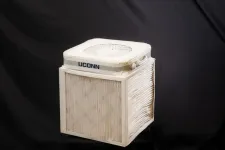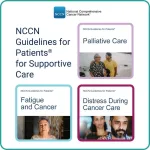(Press-News.org) There is a low-cost way for you to protect yourself and reduce your risk of respiratory diseases such as flu, RSV, and COVID-19. Build yourself a Corsi-Rosenthal box (CR box) in 30 minutes with just $60 worth of common hardware store supplies.
In July, U.S. Environmental Protection Agency scientists began several weeks of advanced bioaerosol chamber testing to assess the efficacy and power of this air filter against infectious aerosols, like the virus that causes COVID-19. The results are in, and they are good.
The U.S. EPA Office of Research and Development’s 3,000 cubic ft. bioaerosol chamber testing results show that the CR box removes 97% of infectious aerosols in just 30 minutes, and 99.4% within 60 minutes. Importantly, the device successfully captures a surrogate virus for SARS-CoV-2, the virus that causes COVID-19.
A team of EPA scientists led by Katherine Ratliff conducted the bioaerosol chamber testing of the CR box after testing more expensive air cleaning technologies throughout the pandemic.
“The study results are extremely exciting,” says EPA’s Ratliff. “These CR boxes really work. The Corsi-Rosenthal box works against infectious aerosols in the air. The results are really powerful. Three different sets of biochamber testing data show that these air filters reduce the amount of infectious virus in the air and capture both smaller and larger sized particles. CR boxes are more effective at reducing concentrations of infectious aerosols in indoor air than some of the more expensive technologies that we tested.”
“These scientific results are huge!” says Marina Creed, APRN, director of the UConn Indoor Air Quality Initiative. “These inexpensive, do-it-yourself air filters are for everyone. If you put this in your home, it will remove infectious germs that cause disease from the air. Schools, students, and teachers if you run one of these inside your classrooms it can reduce your exposure to viruses and bacteria, reducing the risk of disease transmission, meaning you are less likely to get sick.”
Interestingly, the CR box tested by the EPA, known as ‘Owl Force One’, was built, named, and decorated this spring by a then 9-year-old fifth grader and her classmates with members of the UConn Indoor Air Quality Initiative at Macdonough Elementary School in Middletown, Connecticut. The device, decorated as the school’s owl mascot, was driven in July 2023 on a road trip from Connecticut by UConn researchers to the EPA’s Office of Research and Development in Research Triangle Park, North Carolina for the advanced testing. The road trip to the EPA was sparked by then fifth grader, Eniola Shokunbi, 9, now a six-grader, from Middletown who wrote and mailed UConn a letter inviting them to her public school to help her class build the air cleaner and perform experiments.
Creed’s Initiative co-collaborators are Kristina Wagstrom, Ph.D. of UConn School of Engineering, and Misti Zamora, Ph.D. of UConn School of Medicine.
For over two years the UConn team has been building and donating hundreds of these air filters to the Connecticut community, including the state’s public schools, to fight COVID-19 in classrooms while conducting real world testing of the powers of the DIY air cleaners inside schools and other community settings. The researchers have submitted a manuscript for peer review to further build upon the EPA’s testing results.
In June UConn Health donated 150 free CR boxes to vulnerable members of the community to protect them from the dangers of wildfire smoke particles in the air. Also, as a public service, UConn has donated materials and STEM lesson plans for 100 air filters to the Connecticut Education Association for schools and teachers in need of immediately improved indoor air quality this cold and flu season.
You can learn how to build your own simple, affordable DIY air cleaner with UConn’s simple online directions whether for your home, your classroom, or community setting. Also, view a how-to video by UConn School of Engineering students.
The filtration systems are named for their creators, Dr. Richard Corsi, dean of engineering at the University of California-Davis, and Jim Rosenthal, CEO of Texas-based company Tex-Air Filters.
The UConn Indoor Air Quality Initiative’s cross-campus collaborators include: UConn Health and its Comprehensive Multiple Sclerosis Center, UConn School of Medicine and its Department of Public Health Sciences, UConn School of Engineering, UConn School of Nursing, Connecticut Area Health Education Center Network (CT AHEC), UConn Neag School of Education, and Connecticut Children’s.
Informational Resources:
Find out how to build your own DIY air purifier.
Learn more about the UConn Indoor Air Quality Initiative.
Do-It-Yourself Air Cleaners: Making Cleaner Air More Accessible | US EPA
Research on DIY Air Cleaners to Reduce Wildfire Smoke Indoors | US EPA
For the latest updates on this Initiative follow on social media.
END
EPA testing shows the power of D-I-Y air filters to trap viruses
The results are in: US Environmental Protection Agency research testing of do-it-yourself ‘Corsi-Rosenthal Box’ Indoor Air Filters shows they are 99% effective in removing airborne virus
2023-10-30
ELSE PRESS RELEASES FROM THIS DATE:
Year-by-year blood pressure variability from midlife to death and lifetime dementia risk
2023-10-30
About The Study: High blood pressure variability indicated increased lifetime dementia risk in late life but not in midlife in this study that included 820 adults monitored for an average time of 32 years. This result suggests that high blood pressure variability may indicate increased dementia risk in older age but might be less viable as a midlife dementia prevention target.
Authors: Jan Willem van Dalen, Ph.D., of the Radboud University Medical Center in Nijmegen, the Netherlands, is the corresponding author.
To access the embargoed study: Visit our For The Media website at this link https://media.jamanetwork.com/
(doi:10.1001/jamanetworkopen.2023.40249)
Editor’s ...
Sociodemographic disparities and hearing-related quality of life in children with hearing loss
2023-10-30
About The Study: The findings of this study suggest that race and ethnicity and neighborhood disadvantage are associated with hearing-related quality of life in deaf or hard-of-hearing children. The neighborhood association was seen most broadly in children older than 13 years.
Authors: Dylan K. Chan, M.D., Ph.D., of the University of California, San Francisco, is the corresponding author.
To access the embargoed study: Visit our For The Media website at this link https://media.jamanetwork.com/
(doi:10.1001/jamanetworkopen.2023.40934)
Editor’s Note: Please see ...
Imaging brain injury in former national football league players
2023-10-30
About The Study: In this imaging study that included 54 athletes, higher levels of 18 kDa translocator protein (TSPO) that mark brain injury and repair were found in former National Football League (NFL) players compared with former non-collision sport athletes. The NFL players also had lower performance in learning and memory. These findings suggest that further tracking of TSPO levels in relation to neuropsychological performance over time is needed to understand whether these signs persist, progress, and/or warrant neuroimmune-modulating ...
Texas lab unlocks keys to alcohol withdrawal headache
2023-10-30
SAN ANTONIO (Oct. 30, 2023) — About 283 million people worldwide suffer from alcohol use disorder, a debilitating health challenge for which limited therapeutic options are available. The cost to society is estimated at greater than $2 trillion annually.
“People try to rehabilitate, but it is very challenging,” said Yu Shin Kim, PhD, a neuroscience researcher at The University of Texas Health Science Center at San Antonio. “Headache is one of the severe withdrawal symptoms that pushes the rehabilitating patient back to alcohol, because people know that, after drinking, alcohol will actually reduce the headache. It becomes a vicious ...
Improving deep sleep may prevent dementia, study finds
2023-10-30
As little as 1 per cent reduction in deep sleep per year for people over 60 years of age translates into a 27 per cent increased risk of dementia, according to a study which suggests that enhancing or maintaining deep sleep, also known as slow wave sleep, in older years could stave off dementia.
The study, led by Associate Professor Matthew Pase, from the Monash School of Psychological Sciences and the Turner Institute for Brain and Mental Health in Melbourne, Australia, and published today in JAMA Neurology, looked at 346 participants, over 60 years of age, enrolled in the Framingham Heart Study who completed two overnight sleep studies in ...
Innovative antibody approach targets deep-seated cancer mutations
2023-10-30
DURHAM, N.C. -- For too long, cancer treatment has been a double-edged sword – the very treatments designed to kill cancer cells often wrought havoc on healthy ones too.
But a new study published online Oct. 30 in Immunity, a Cell Press journal, unveils an approach to cancer treatment that researchers describe as more precise, long-lasting, and less toxic than current therapies.
The work, led by Duke University School of Medicine immunology researcher Jose Ramon Conejo-Garcia, MD, PhD, centers on the innovative use of IGA antibodies ...
Cancer Research Institute awards Ananda Goldrath, Ph.D., with the 2023 Frederick W. Alt Award
2023-10-30
SEATTLE, WASH.—October 30, 2023—The Cancer Research Institute (CRI) has awarded Ananda Goldrath, Ph.D., Executive Vice President and Director of the Allen Institute for Immunology, the 2023 Frederick W. Alt Award. This award is given to former Cancer Research Institute postdoctoral fellows who have achieved outstanding success in academia or industry for innovative research that has advanced knowledge and understanding in the field of immunology.
“The Cancer Research Institute has been supporting ...
NCCN expands focus on quality of life and supportive care with new guides for people with cancer
2023-10-30
PLYMOUTH MEETING, PA [October 30, 2023] — The National Comprehensive Cancer Network® (NCCN®) is announcing new resources focused on improving quality of life for people with cancer while making sure care planning reflects individual needs and priorities. Today marks the publication of a new NCCN Guidelines for Patients®: Palliative Care, part of an ongoing expansion of supportive care resources. The new NCCN Guidelines for Patients: Fatigue and Cancer is also publishing, along with an updated book on managing Distress During Cancer Care.
The NCCN Foundation® provides funding for the NCCN Guidelines for ...
Helping robots assess risk
2023-10-30
“For robots to achieve true autonomy in the future, they must be able to assess risks before making decisions,” says Nader Motee (pictured below), a professor of mechanical engineering and mechanics in Lehigh University's P.C. Rossin College of Engineering and Applied Science.
Motee recently received a nearly $680,000 grant from the Office of Naval Research to develop a novel, multi-stage, perception-based control paradigm that will essentially help robots assess risk, and ultimately make autonomous systems safer and more efficient.
We humans conduct ...
Want to achieve your goals? Get angry
2023-10-30
WASHINGTON -- While often perceived as a negative emotion, anger can also be a powerful motivator for people to achieve challenging goals in their lives, according to research published by the American Psychological Association.
“People often believe that a state of happiness is ideal, and the majority of people consider the pursuit of happiness a major life goal,” said lead author Heather Lench, PhD, a professor in the department of psychological and brain sciences at Texas A&M University. “The view that positive emotion is ideal ...
LAST 30 PRESS RELEASES:
New study highlights link between eviction rates and gun violence
Heatwaves heat up soil but not toxin levels in rice, study finds
Digital modeling reveals where construction carbon emissions really come from
Turning farm waste into water filters
New study shows how the spleen helps the immune system accept a transplant
New Mayo Clinic study advances personalized prostate cancer education with an EHR-integrated AI agent
Researchers identify novel therapeutic target to improve recovery after nerve injury
Microbes in breast milk help populate infant gut microbiomes
Reprogramming immunity to rewrite the story of Type 1 diabetes
New tool narrows the search for ideal material structures
Artificial saliva containing sugarcane protein helps protect the teeth of patients with head and neck cancer
Understanding the role of linear ubiquitination in T-tubule biogenesis
Researchers identify urban atmosphere as primary reservoir of microplastics
World’s oldest arrow poison – 60,000-year-old traces reveal early advanced hunting techniques
Bristol scientists discover early sponges were soft
New study uncovers how rice viruses manipulate plant defenses to protect insect vectors
NSF–DOE Vera C. Rubin Observatory spots record-breaking asteroid in pre-survey observations
Ribosomal engineering creates “super-probiotic” bacteria
This self-powered eye tracker harnesses energy from blinking and is as comfortable as everyday glasses
Adverse prenatal exposures linked to higher rates of mental health issues, brain changes in adolescents
Restoring mitochondria shows promise for treating chronic nerve pain
Nature study identifies a molecular switch that controls transitions between single-celled and multicellular forms
USU chemists' CRISPR discovery could lead to single diagnostic test for COVID, flu, RSV
Early hominins from Morocco reveal an African lineage near the root of Homo sapiens
Small chimps, big risks: What chimps show us about our own behavior
We finally know how the most common types of planets are created
Thirty-year risk of cardiovascular disease among healthy women according to clinical thresholds of lipoprotein(a)
Yoga for opioid withdrawal and autonomic regulation
Gene therapy ‘switch’ may offer non-addictive pain relief
Study shows your genes determine how fast your DNA mutates with age
[Press-News.org] EPA testing shows the power of D-I-Y air filters to trap virusesThe results are in: US Environmental Protection Agency research testing of do-it-yourself ‘Corsi-Rosenthal Box’ Indoor Air Filters shows they are 99% effective in removing airborne virus






